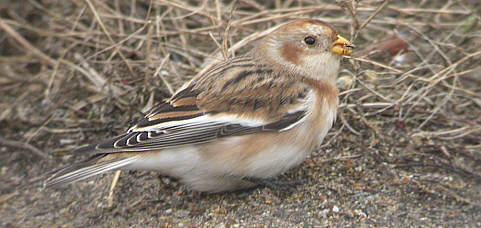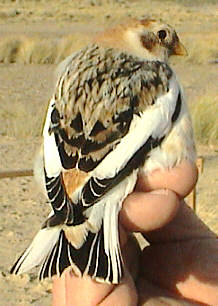|
Snow Buntings on Kessingland Beach Winter
2003/04 |

by Colin Carter
Snow Buntings have in the past wintered on Kessingland Beach, near Lowestoft, but in the winter 2003/2004 the flock-size rose to 100+, greater than had been previously recorded (maximum actual count 103 on 4th January). This may have been due to feeding, but increased numbers were also reported elsewhere.

 131
birds were trapped, suggesting some turnover in the flock. Of these,
5 had been ringed at Caister-on-sea, Norfolk on 29th November 2003
and had moved south (28km). 125 of the 131 were ringed with BTO rings
and 12 of these were controlled at Caister later in the winter, having
moved north. 29 birds were colour-ringed under a late-developed scheme.
1 bird with a deformed foot was released unringed.
131
birds were trapped, suggesting some turnover in the flock. Of these,
5 had been ringed at Caister-on-sea, Norfolk on 29th November 2003
and had moved south (28km). 125 of the 131 were ringed with BTO rings
and 12 of these were controlled at Caister later in the winter, having
moved north. 29 birds were colour-ringed under a late-developed scheme.
1 bird with a deformed foot was released unringed.
86% of the birds handled were of the Icelandic race insulae and the remainder of the Scandinavian/ Greenland race nivalis. Both races seemed to mix freely.
77% of all the birds were 1st-winter females - it is presumed that adults, especially males, remain close to their breeding grounds.
The Snow Buntings quickly became accustomed to the seed-bait - in this case mixed corn - and all credit is due to Paul Read (and dog Eric) for topping up the seed-patch each day.
The beach flooded 3 times during the winter, interrupting this project, but the last flood brought some Turnstones close to and eventually into the baited area. As a result 15 Turnstones were also trapped and ringed.
Photo
right: Adult male Snow Bunting of the race nivalis © Paul Read
Details
of bird ringing carried out at Corton in the Autumn of 2003 can be
viewed here.